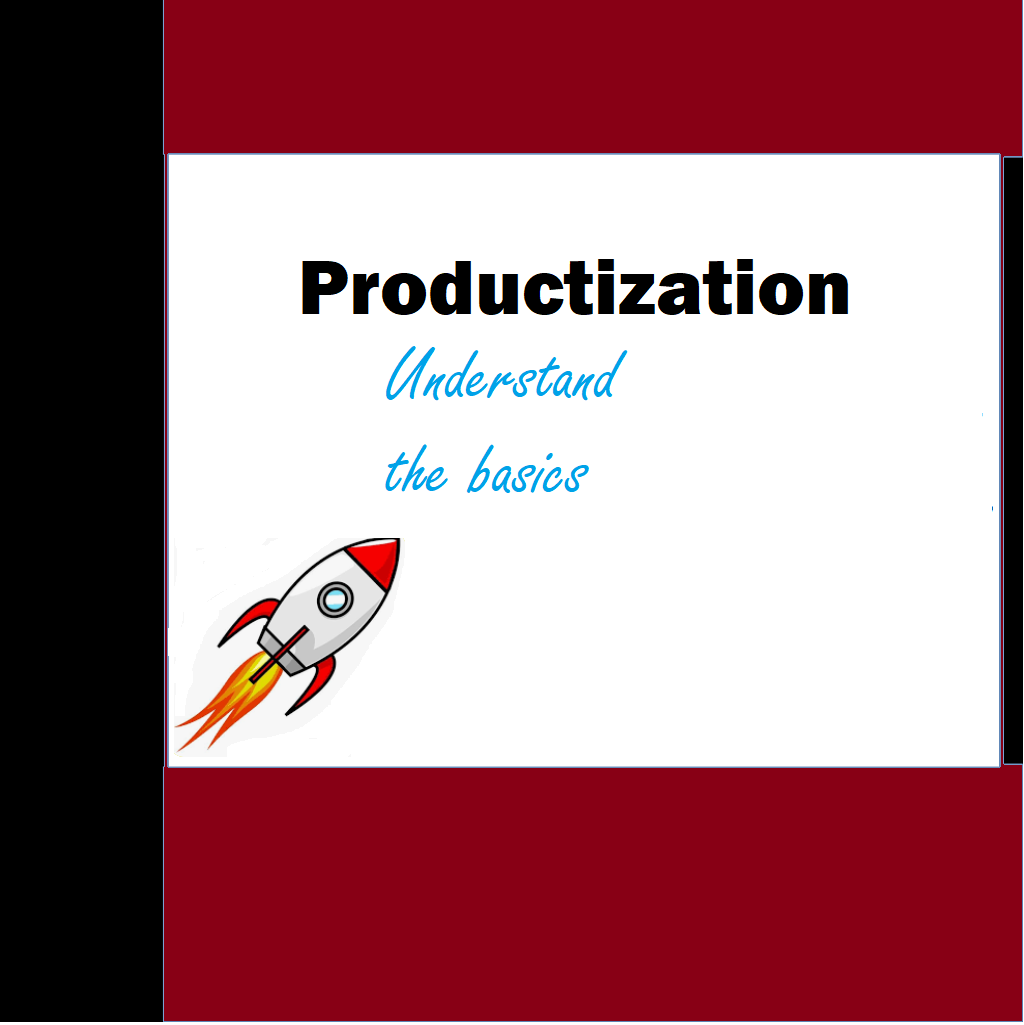Productization is the process of turning a service, idea, or solution into a tangible and marketable product. It involves taking something that may initially exist in a more abstract or customized form and transforming it into a standardized, packaged offering that can be sold to a wider audience. This concept is commonly used in business and entrepreneurship to create scalable and profitable ventures.
Key aspects of productization include:
- Standardization: The first step in productization is to standardize the offering so that it can be replicated and delivered consistently to multiple customers. This often involves defining clear specifications, features, and a well-defined scope.
- Scalability: Productization aims to make the offering scalable, meaning it can be efficiently produced and distributed to a large number of customers without a proportional increase in costs or complexity.
- Packaging: The productized offering is typically presented in a way that is easy for customers to understand and access. This may involve creating user-friendly interfaces, documentation, and marketing materials.
- Pricing: Establishing a clear and competitive pricing strategy is crucial in productization. This involves determining the value of the product to customers and setting a price that reflects that value while ensuring profitability.
- Marketing and Sales: Productized offerings require marketing and sales efforts to reach potential customers. This includes identifying target markets, developing marketing strategies, and building sales channels.
- Support and Maintenance: Providing customer support and ongoing maintenance may be necessary to ensure customer satisfaction and the long-term success of the productized offering.
Productization is often used in industries such as software development, consulting, and professional services, where turning expertise, solutions, or intellectual property into marketable products can lead to increased revenue and growth. It allows businesses to reach a broader customer base and establish more predictable revenue streams compared to custom, one-off services or solutions.
CONTENT
Capitalization on productized product or service
Way productization works.
Productization is a strategic process that involves transforming a service, idea, or solution into a marketable product. Here’s a step-by-step guide on how productization works:
- Conceptualization: Start by identifying a service, expertise, or solution that you provide, which has value and potential demand in the market. This could be a unique skill, software tool, consulting service, or any other offering.
- Standardization: Define clear specifications and standardize the offering as much as possible. This means creating a consistent and replicable framework for delivering the product. Standardization simplifies production and ensures consistent quality.
- Scalability: Assess whether the offering can be scaled efficiently. Consider factors like resource requirements, production costs, and the ability to handle increased demand without a significant increase in expenses. Scalability is crucial for long-term success.
- Packaging: Design the product’s packaging, both in terms of its physical presentation (if applicable) and its digital or online presence. This includes creating user-friendly interfaces, documentation, and marketing materials.
- Pricing Strategy: Determine the pricing structure for your product. Consider factors such as the value it provides to customers, competitors’ pricing, and your own cost structure. Pricing should be competitive while ensuring profitability.
- Marketing and Sales: Develop a comprehensive marketing and sales strategy. Identify your target audience and create marketing materials to reach them. Establish sales channels, whether it’s through your website, e-commerce platforms, or partnerships.
- Customer Support and Maintenance: Plan for customer support and ongoing maintenance. Ensure that customers can easily access help when needed and that your product remains up-to-date and functional.
- Testing and Quality Assurance: Before launching, thoroughly test your product to identify and resolve any bugs or issues. Quality assurance is crucial to maintain a positive reputation.
- Launch: Release your product to the market. This could involve a soft launch to a limited audience or a full-scale launch to a broader customer base. Marketing efforts should coincide with the launch to generate initial interest.
- Feedback and Iteration: Listen to customer feedback and be prepared to make improvements. Continuous iteration based on user feedback can help your product evolve and stay competitive.
- Scaling and Growth: As your product gains traction and generates revenue, focus on scaling your operations to meet growing demand. This might involve hiring more staff, expanding marketing efforts, or enhancing your product’s features.
- Monitoring and Analytics: Implement analytics tools to track product performance and customer behaviour. Use this data to refine your marketing strategies and further optimize the product.
Productization is an ongoing process that requires adaptability and a commitment to meeting customer needs. By following these steps and continuously refining your product and strategies, you can successfully turn your service or solution into a marketable and profitable product.
Real World Concept example
To illustrate the real-world concept of productization, let’s consider an example involving software development services:
Imagine a software development company that initially provides custom software solutions to its clients. They work closely with each client to understand their specific needs and develop tailored software applications. While this approach can be profitable, it often leads to a labour-intensive and unpredictable workflow. The company decides to shift towards productization to create a more scalable and profitable business model.
Here’s how they implement productization in the real world:
- Identifying Expertise: The company evaluates its areas of expertise and identifies a particular niche where they have deep knowledge, such as e-commerce website development.
- Standardization: Instead of building custom e-commerce websites from scratch for each client, the company develops a standardized e-commerce platform with a range of features that can be easily customized.
- Scalability: By creating a scalable platform, the company can now serve multiple clients simultaneously without significantly increasing their development team’s size.
- Packaging: They package their e-commerce platform with user-friendly documentation, a content management system, and e-commerce-specific features like shopping cart functionality.
- Pricing Strategy: The company establishes a pricing structure based on the number of products a client wants to sell, the level of customization required, and additional support and maintenance services.
- Marketing and Sales: They create marketing materials that highlight the benefits of their e-commerce platform, targeting businesses looking to set up online stores. They also optimize their website for search engines and utilize social media to reach potential customers.
- Customer Support and Maintenance: The company offers various support plans, including regular updates, security patches, and technical assistance to maintain the e-commerce platform’s functionality.
- Testing and Quality Assurance: Rigorous testing is conducted to ensure the e-commerce platform is stable, secure, and user-friendly.
- Launch: They officially launch the productized e-commerce platform, and customers can purchase licenses or subscriptions directly from the company’s website.
- Feedback and Iteration: They actively seek customer feedback and use it to make improvements to the platform, adding new features and addressing any issues.
- Scaling and Growth: As more businesses adopt their e-commerce platform, the company scales its operations, possibly expanding its team and customer support infrastructure.
- Monitoring and Analytics: They use analytics tools to monitor the platform’s performance and user behaviour, refining their marketing strategies based on data-driven insights.
By productizing their software development expertise into a standardized e-commerce platform, the company can now serve a broader market, generate more predictable revenue, and establish itself as a go-to solution provider for businesses seeking e-commerce solutions. This real-world example demonstrates how productization can transform a service-based business into a scalable and profitable venture.
Capitalization on productized product or service
Capitalizing on a Productized Product or Service
Productization can be a game-changer for your business, but it’s crucial to know how to effectively capitalize on your productized offering. Here’s a step-by-step guide:
- Market Research: Start by conducting thorough market research. Understand your target audience, their pain points, and their preferences. Identify competitors and analyse their productized offerings to find gaps or opportunities for differentiation.
- Value Proposition: Clearly define your product’s unique value proposition. What sets it apart from the competition? Why should customers choose your productized offering over others? Communicate this value proposition effectively in your marketing materials.
- Pricing Strategy: Develop a pricing strategy that reflects the value your product provides. Consider factors like production costs, competitors’ pricing, and what your target market is willing to pay. Experiment with different pricing models, such as subscription-based or one-time purchase options.
- Marketing and Promotion: Invest in marketing and promotion to create awareness and demand for your product. Utilize various channels, including online advertising, social media, content marketing, and email campaigns. Tailor your marketing efforts to reach your target audience effectively.
- Customer Education: Educate potential customers about the benefits and features of your productized offering. Create informative content such as blog posts, tutorials, webinars, or videos that highlight how your product can solve their specific problems.
- Sales Channels: Establish efficient sales channels to make it easy for customers to purchase your product. This may include optimizing your website for online sales, setting up an e-commerce platform, or forming partnerships with distributors.
- Customer Support: Provide exceptional customer support to enhance the overall customer experience. Respond promptly to inquiries, offer assistance, and address any issues or concerns. Happy customers can become loyal advocates for your product.
- Feedback Loop: Actively seek feedback from customers and use it to improve your productized offering continuously. Pay attention to customer reviews, conduct surveys, and engage with users on social media. Incorporate valuable feedback into product updates and enhancements.
- Upselling and Cross-Selling: Explore opportunities to upsell and cross-sell additional products or services to existing customers. This can increase the average revenue per customer and drive profitability.
- Retention Strategies: Implement strategies to retain customers over the long term. Offer subscription renewals, loyalty programs, and exclusive benefits to incentivize customers to stay with your product.
- Scaling Efforts: As your product gains traction, be prepared to scale your operations. This might involve expanding your team, enhancing infrastructure, and optimizing processes to accommodate growth.
- Data Analytics: Leverage data analytics tools to gather insights into customer behaviour and product performance. Use these insights to make informed decisions, refine your marketing strategies, and identify opportunities for growth.
- Partnerships and Collaborations: Explore partnerships or collaborations with complementary businesses to expand your reach and access new customer segments. Joint ventures and affiliate programs can be mutually beneficial.
- Continuous Innovation: Stay ahead of the competition by continuously innovating and improving your product. Keep an eye on industry trends and emerging technologies that can enhance your offering.
- Profitability Analysis: Regularly evaluate the profitability of your productized offering. Analyse costs, revenues, and ROI to ensure that your capitalization efforts are generating the desired financial results.
By following these steps and adapting your strategies based on market dynamics and customer feedback, you can effectively capitalize on your productized product or service, drive revenue growth, and establish a strong presence in your target market.





